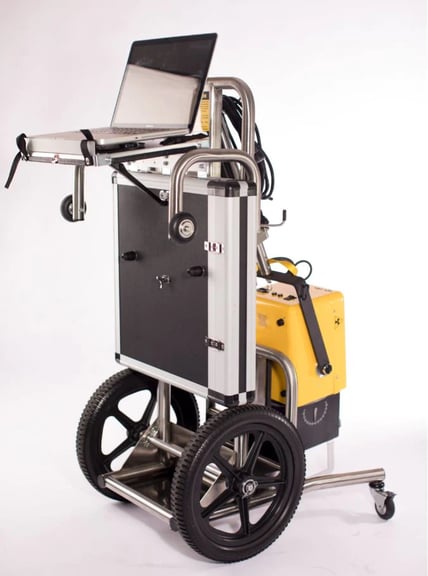The mobile radiology and imaging industry is in high demand, and many people are investigating what it takes to establish their own business in the space.
These mobile units provide crucial screening to isolated regions and patients that are unfit for travel.
A portable x-ray business can be highly profitable, but there are a lot of factors to consider before investing. Establishing this type of business involves steps that include creating a business plan, licensing, public health compliance, acquisition of equipment, and insurance.

Here are some of the steps you can take, and common mistakes to avoid, when looking to start a mobile x-ray business:
A Step-by-Step Process
When looking to open this type of business, below are some important parts of the process to consider.
Step #1) Develop a Business Plan
It doesn’t matter what type of business you are starting, it always begins with a well-formulated plan. In order to fund your business, you must first put to paper exactly how you plan to run it.
There are 7 key elements to a successful business plan. These are:
- Executive Summary
- Background, Objectives, and Mission
- Products and Services
- Marketing Plan
- Competitive Analysis
- Operational Plan
- Financials
In your financial planning section, you’ll want to include how you expect the business to be funded (i.e. venture capital, grant, or a Small Business Administration (SBA) loan).
You should also include costs for the vehicle/s needed to carry your new radiology equipment and budget projections for start-up costs.
Additionally, in your business layout, have plans for hiring licensed personnel to operate the equipment. Lastly, you must determine exactly which types of clients and communities will be served.
Step #2) Address Licensing and Requirements
Every state is different, so the next step is to check what the licensing requirements are for your particular region. If the radiology unit is traveling to or operating in another state, you will have to check those licensing requirements as well.
Wherever you plan to operate the business, is where you should be covered. The American Registry of Radiologic Technologists can provide you with further information about each state’s registration and license requirements. The American Portable Diagnostics Association (APDA) is also a great resource for anyone looking to start a mobile x-ray business.

Step #3) Establish Business Ownership
To be taken as a serious business, the next step is to form an entity to establish ownership. Choosing the right type of business structure can be a challenge, so make sure you do your homework. Options include:
- Non-profit
- Sole Proprietorship
- For-profit
Next, register your portable radiology business with the Secretary of State in the states you plan to operate.
Step #4) Purchase Your Mobile X-ray Equipment
Now, it’s time to start building your inventory. This starts with purchasing a mobile x-ray system.
If you’re not sure about where to begin, Maven Imaging has decades of combined experience in the mobile x-ray business. has been in business for decades. We are experts on portable and mobile digital x-ray systems and have solutions for all types of budgets and clinical applications. Some top brands to consider are:
The cost of a portable x-ray system can vary by brand and type of imaging. If you’re not sure, it’s always a good idea to ask the sales rep for further clarification.
Step #5) Become a Healthcare Provider
One of the most important steps in the process is for your business to become a licensed healthcare provider. Contact the Department of Health in the states you plan to operate the portable x-ray equipment.
This means you must also become a provider for all the health management organizations and insurance companies operating in the regions served (as well as Medicare). Doing this will ensure your business can provide service to a broad range of the population.
Step #6) Get Insured
It’s important that your business is completely insured and covered prior to operating. The medical industry is one of the most insured industries on the planet, and this is not an area you want to take lightly.
Consult with an insurance company about the proper amount of coverage in your area. Make sure you enroll with an insurer that includes medical malpractice, and that you cover all personnel on your team.

Step #7) Comply with Privacy Laws
It is crucial that you respect privacy in healthcare and comply with all medical-records privacy laws, including HIPAA. If you’re not sure of what those are, a copy is available on the website of the Department of Health and Human Services.
Familiarize yourself with state and national laws regarding medical-record keeping. It might also be a good idea to draft a privacy policy and make it available to all staff and patients.
Step #8) Find a Radiology Group
After the imaging is done, you’ll need someone to interpret the x-rays and put together a report. A radiology team can help you get this done quickly and efficiently. This can consist of doctors, technologists, nurses, or medical staff. Some diagnostic service providers also utilize programs with advanced AI to deliver faster and more accurate reads.
Top Mistakes to Avoid When Starting a Mobile X-ray Business
When it comes to starting a business like this, people often run into obstacles. Listed below are some of the biggest mistakes you can make when buying an x-ray system and how to avoid them.
Underestimating Timeframes
When it comes to healthcare, it takes a while to get approval. New healthcare providers can wait months to enroll with Medicare and receive a National Provider Identification (NPI) number.
Please note: Both Medicare enrollment and an NPI are necessary to run a portable x-ray business.
Additional laws to consider involve:
- Audits
- Licensing
- Insurance plans
Your state and county specialist can better explain specific regulations, enrollment procedures, and timeframes to anticipate.
Conceptualizing the True Cost
Running a portable x-ray business is costly and there are a lot of upfront expenses. Choose equipment that will meet your current needs and build up from there. Anything you can do to minimize initial capital expenditure will help the business grow faster.
Don’t purchase an inexpensive vehicle, either. The right vehicle is critical and must provide enough space to accommodate the hardware. Other costs that will affect your bottom line include:
- Gas mileage
- Deciding between new or used equipment
- Labor
Make sure you sit down and list out every anticipated expense so that no cost comes as a surprise when you least expect it.

Overexpanding Your Service Area
Try not to offer too much to too many people. It’s the classic case of spreading yourself too thin. Some providers, hoping to increase their portable x-ray business, will expand both the service area and types of procedures they offer. This can prove a disaster.
When just starting out, it’s incredibly important to choose local territories with a good customer base. Do not ignore the expense of traveling far and the turn-around times involved. It is also vital that you specifically pinpoint the type of services needed most in your area of operation.
Know exactly what your potential customers need, and have the ability to provide for them efficiently.
Passing on Software Updates
When it comes to portable and digital imaging, it’s vital not to pass over the best software. Some providers use a Picture Archiving and Communication System (PACS) to retrieve and store electronic images. This machine is costly and can be somewhat of a hassle to maintain. It can also limit the practice management ability of the provider.
Modern mobile x-ray companies are choosing a more secure and encrypted solution. There are programs out there that offer long-term storage of images and in-depth reporting with billing and 3rd -party integration.
Forgetting About the Human Approach
The support staff is absolutely essential when running a mobile business. Not only do you need trained technologists to perform the procedures, but you need administrative and customer support to keep the business running.
If no one is in the back office manning the phones, people can’t get through to schedule. Fewer service call means less revenue. New providers can’t afford that.
Summing it Up
Starting a mobile x-ray business means paying attention to detail. It’s not like most other startups because you are dealing with patients and their health. Therefore, the industry is highly regulated. It makes sense to do your homework first and determine if you have an audience for it. Rural areas are a good start as people often don’t have the same access as those in urban settings.
You should also do some thorough research on price and service areas. Oftentimes people purchase too much or the wrong type of equipment for the demand in their area. The more work you put into proactive education, the more likely your business will flourish.
If you have any questions about the right mobile x-ray equipment for your business, reach out. Maven Imaging is here to help you find the best price point, type of equipment, and financing to get your business started today!

